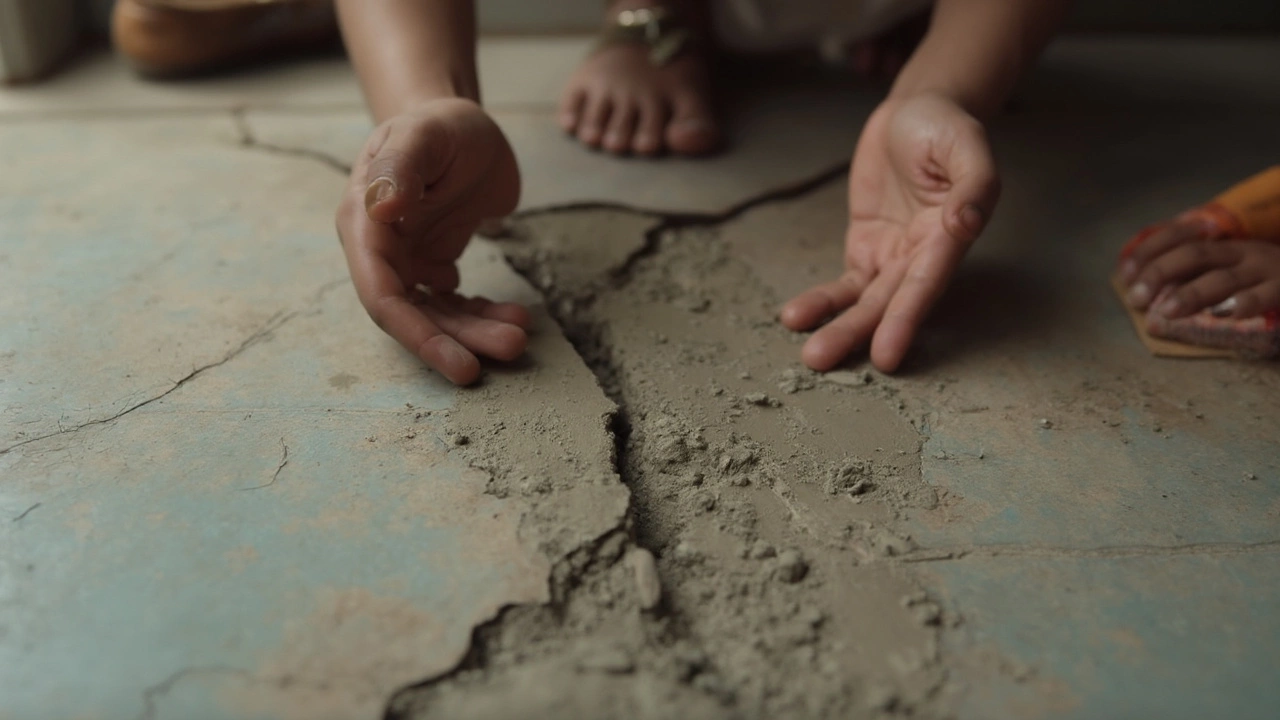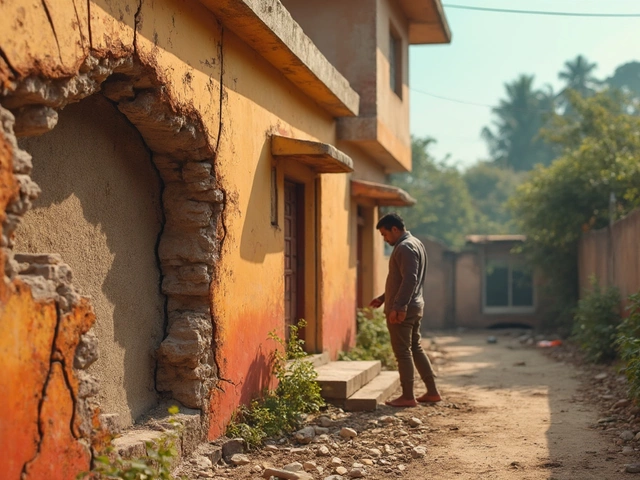Pick the wrong cement and your foundation crack could show up again before you even get your tools cleaned. Not every cement on the shelf is meant for tough jobs like foundation repair. Some harden too quickly, others don’t grab onto old concrete, and a few just plain crumble under pressure.
If your foundation needs more than a bandage, you have to know what products actually stand up to soil movement, water, and weight from above. It’s not just about what’s on sale at the hardware store—using the right kind of cement can save you from repeat repairs, extra costs, and frustration down the road. This guide will help you spot the difference between a mix that’ll hold up and one that’s a waste of money.
- Why the Type of Cement Matters
- When Regular Concrete Isn’t Enough
- Spotlight on Hydraulic Cement
- Specialty Repair Mixes: Are They Worth It?
- Mixing and Applying Cement the Right Way
- Tips for Long-Lasting Results
Why the Type of Cement Matters
Foundation repair is no place for guesswork. The type of cement you choose can actually make or break your fix—literally. Regular masonry cement, for example, might seem fine for a crack or two, but it often shrinks and pulls away from the existing slab, especially if moisture is involved. Meanwhile, specialized repair mixes are literally made to stick and hold where common bagged cement fails.
Let’s talk facts: The main jobs for cement in foundation repair are sticking to old concrete, resisting water, and not shrinking. Portland cement is the basic ingredient in almost every mix, but all cements are not created equal. Some have extra ingredients that stop water seepage or make them expand just slightly, so there’s no ugly gap after things dry up.
Here’s a quick look at how different types of cement compare for foundation repairs:
| Type of Cement | Bonds to Old Concrete | Water Resistance | Shrinkage |
|---|---|---|---|
| Standard Concrete Mix | Fair | Poor | High |
| Hydraulic Cement | Very Good | Excellent | Very Low |
| Epoxy-Based Mixes | Excellent | High | Low |
| Polymer-Modified Concrete | Good | Very Good | Low |
The wrong mix means cracks come back or water finds its way in. Hydraulic cement, for example, can set up quick (even in wet conditions), so it's often used to plug active leaks. Polymer-modified or epoxy repair mortars are pricier, but they clamp down tight and last a long time.
All this boils down to one thing: not all cement is built to do the tough job of fixing foundations. Know what you’re using before you open that bag or bucket.
When Regular Concrete Isn’t Enough
Standard concrete mixes sound like a safe bet, but when it comes to foundation repair, they often don’t cut it. Regular concrete, made from Portland cement, sand, gravel, and water, is built for new slabs or sidewalks—not cracked foundations under stress. If you try patching foundation cracks with basic concrete, it’ll probably fail. Why? Because foundation repairs put the material through way more tension and movement than sidewalks or patios ever see.
Most cracks in foundations start because of groundwater, soil shifting, or settling. Regular concrete isn’t flexible or quick-setting enough to keep up with these changes. That’s why a lot of homeowners find their patch jobs crumble or pop out after just one winter or rainy season.
Here’s a quick look at why regular mixes fall short compared to those made for foundation repairs:
| Feature | Regular Concrete | Specialty Repair Mix |
|---|---|---|
| Sets Under Water | No | Yes (some types) |
| Resists Shrinking | Poorly | Good |
| Bonds to Old Concrete | Weak | Strong |
| Handles Tension/Movement | Not well | Very well |
| Fast Setting | No | Most do |
Specialty repair cements usually have additives to help them bond to existing surfaces and handle moisture better. For example, foundation repair cements often use polymers or hydraulic ingredients that let them harden even if there’s a bit of water around. That’s a huge plus for patching basement cracks—since those cracks always seem to get wet no matter what you do.
If you spot hairline cracks, sure, you can squeeze by with some basic concrete or even caulk for a quick fix. But anything wider than a quarter-inch, or anything actually leaking, calls for a repair mix built for the job. Otherwise, you’ll just be chasing the same crack year after year like it’s some kind of bad plumbing joke.
Spotlight on Hydraulic Cement
If you ask any contractor about quick fixes for cracked foundations, hydraulic cement comes up almost every time. It’s a go-to for a reason. Hydraulic cement is a special blend of powders that harden, or 'set,' when water’s added—unlike standard cement, it actually cures even when wet. That makes it a game changer for patching leaks or cracks in concrete that’s below the water line or regularly fighting off ground moisture.
Here’s the thing: hydraulic cement works super fast. Once mixed, you usually have just 3-5 minutes before it starts to firm up, so you can't mess around. What’s awesome is, in that time, it expands a little, which helps seal up even small cracks tight. Homeowners use it to fill everything from tiny hairline cracks to gaping holes in foundation repair projects.
Why does it matter for foundations instead of just regular concrete? Take a look at a few real benefits:
- Stops water in its tracks—even if it’s flowing (not just damp).
- Sticks to old concrete without the need for bonding agents.
- Doesn’t shrink when it dries, so the repair doesn’t pull away from the old surface later.
- Ready in minutes, not hours or days.
A 2023 study by the American Concrete Institute found that hydraulic cement had a 90% success rate in stopping active leaks in commercial basements, compared to about 70% for other patch materials. That’s a huge difference if you’re fighting groundwater.
Check out some real numbers on hydraulic cement’s properties versus regular concrete mix:
| Property | Hydraulic Cement | Regular Concrete Mix |
|---|---|---|
| Set Time (minutes) | 3-5 | 60-120 |
| Water Resistance | High | Moderate |
| Shrinkage | Low | Medium |
| Bonds to Wet Surfaces | Yes | No |
| Usable for Underwater Repairs | Yes | No |
One thing to remember: hydraulic cement isn’t flexible. It works best in stable cracks—if your foundation is still moving or shifting, you’ll need more than just a quick patch. But for sealing leaks and small, stubborn cracks, it’s hard to beat. Always prep the crack by chiseling it wider at the base and removing loose bits before you slap any repair mix in there. That’s key to getting the patch to last.

Specialty Repair Mixes: Are They Worth It?
Walk through any home store and you’ll spot bags labeled "foundation repair mix," "quick-set blend," and “structural patch.” These aren’t just marketing tricks—specialty repair mixes actually work differently from regular cements. They usually pack in additives that make them stick better, cure faster, and block water more effectively. That’s a big deal with nasty cracks in the basement or a slab fighting off groundwater.
Let’s get practical. Take epoxy-modified repair mortars—a lot of contractors swear by these for patching because epoxy helps the mix bond straight onto old, worn-out concrete. Then there’s polymer-modified cement, another favorite for filling deep holes and cracks, especially when you can’t keep things dry. These specialty mixes often reach full strength a lot faster. For example, some can handle serious load in as little as 24 hours, compared to traditional concrete that might need three days or more.
Check out how some top repair mixes stack up:
| Mix Type | Bond Strength (psi) | Compressive Strength (psi) | Initial Set Time |
|---|---|---|---|
| Standard Concrete | 200-400 | 3500-4000 | 2-4 hours |
| Polymer-Modified Repair Mix | 800-1200 | 5000+ | 30-45 minutes |
| Epoxy-Modified Mortar | 1500+ | 8000+ | 15-30 minutes |
Sure, these bags cost more up front. Still, skipping specialty repair mixes on a stubborn puncture or active crack usually means you’ll just fix it twice. That’s why most pros reach for these when durability, waterproofing, and strong foundation repair matter.
Bottom line: if you need to mend a structural gap, fill a moving crack, or seal out water, a specialty repair mix is usually worth the higher price. Just make sure to read the label and match the product to your exact problem. The right blend now saves time, hassle, and another weekend project later.
Mixing and Applying Cement the Right Way
Getting the mix right is half the battle. If you just dump water and hope for the best, odds are you’ll end up with weak patches or cracks that come back. Most bags of cement or repair mix have ratios on the label, and you actually need to follow them. Adding too much water makes the cement weak and chalky—too little, and it won’t bond.
Here’s a basic breakdown of mixing for foundation repair (and yes, it does differ a little from mixing for a regular sidewalk):
- Foundation repair cement usually needs less water than concrete for sidewalks or patios. Aim for a thick, peanut butter-like consistency, not soup.
- Use clean water without added chemicals. Dirty water can mess with the setting process.
- Always start by pouring water into your mixing bucket first, then slowly add the cement powder while stirring. It prevents dry clumps.
- If you’re mixing more than a bag or two, rent a mixer. For one-bag jobs, a sturdy stick or paddle drill attachment works fine.
When applying the cement, prep is everything. Remove any dust, loose bits, or paint from the crack or patch area. If you skip this, the cement might not bond and you’re looking at another repair soon. Use a wire brush or a power washer if the concrete’s especially grimy.
After the area’s clean, lightly dampen it with water—don’t soak it, just get it moist. This helps the new cement stick to what’s already there. Cram the cement deep into the crack or patch, making sure you pack it tight. A trowel, putty knife, or even a gloved hand can help smooth out the surface. Most repair cements start to harden in 10-20 minutes, so work fast.
As for curing, you need to keep the patched area damp for at least 24 hours. Lay a plastic sheet or lightly mist the spot every few hours. This prevents it from drying out too fast and cracking again. Most pros say the area should stay above 50°F for proper curing—otherwise, it takes longer or might not set right.
| Fact | Why It Matters |
|---|---|
| Water-to-powder ratio (for repair mixes) | Usually about 3-3.5 quarts per 50-lb bag; too much water weakens the bond |
| Working time | 10-20 minutes before cement begins hardening |
| Curing | Keep damp for at least 24 hours to avoid shrinkage cracks |
| Cleaning the old concrete | Boosts adhesion and long-term durability |
Nobody loves spending time on prep or cleanup, but skipping these steps is the most common reason foundations repairs fail. The little details make a big difference when you want a patch that actually lasts.
Tips for Long-Lasting Results
If you want your foundation repair to last, it’s not just about what cement you use—it’s how you handle everything from prep to the final cleanup. Even the best cement can fail if the basics are skipped.
Start with prep. Any dirt, oil, or loose concrete sitting in the crack will keep fresh cement from sticking. Use a wire brush or a pressure washer (if you’ve got it) to clean the spot until it looks bare. Trust me, this makes all the difference.
Here’s a quick list of habits that set you up for a repair that actually lasts:
- Moisture control: Don’t slap new cement onto a soaked or puddled area. Let it dry a bit but keep it slightly damp (not flooded) when you pour or press in the cement. This helps with adhesion and reduces shrinking.
- Mix accuracy: Stick to the manufacturer’s water-to-mix ratio. Eyeballing it can make the cement too runny or too stiff. Too much water weakens the repair; too little and you’re fighting the mix.
- Layering matters: Fill deep cracks in layers, maybe half an inch at a time. Slam it in gently with a trowel so there’s no air trapped inside—that’s what causes crumbling later on.
- Cure it right: After you’re done, keep the surface covered and moist for at least 48 hours. Throw a damp towel over it or use plastic wrap. Fast drying makes it weak and flaky.
- Seal the deal: Once it’s cured, sealing the area with a quality concrete sealer will block out water, which is the number one enemy of foundations.
Ever wonder how much difference these steps make? Take a look at the stats below. A 2021 industry report found that repairs done with proper cleaning, correct mix, and curing had failure rates under 3% in the first five years, while rushed jobs shot up to 19%!
| Repair Practice | 5-Year Failure Rate |
|---|---|
| Proper prep, mix, and curing | 2.8% |
| Poor prep or wrong cure | 19.1% |
Don’t put tools away too quickly. Double check that the surface doesn’t have gaps or dry spots. Tiny details now mean you’re not coming back to the same crack next year. The extra care up front is a lot cheaper than doing the whole process again.



Write a comment